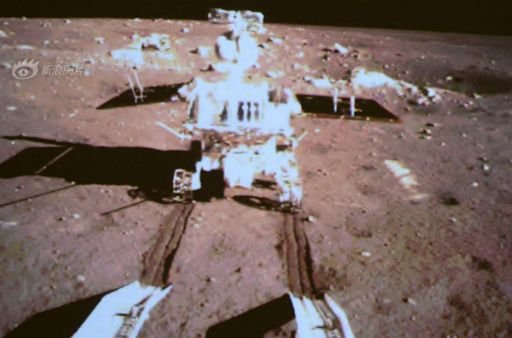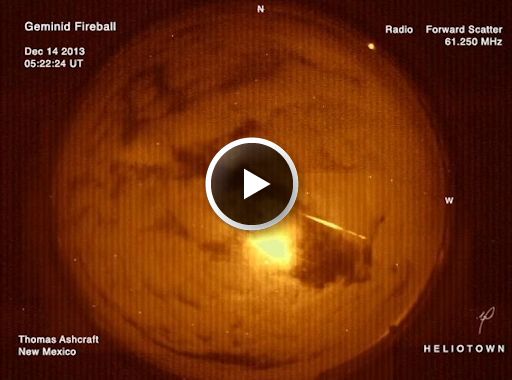CHANCE OF STORMS: NOAA forecasters estimate a 40% chance of polar geomagnetic storms on Dec. 15th when a pair of CMEs could deliver rapid-fire glancing blows to Earth's magnetic field. High-latitude sky watchers should be alert for auroras mixed with bright moonlight. Aurora alerts: text, voice
CHINA LANDS ON THE MOON: Move over USA and Russia. China has joined the club of nations that has landed on the Moon. On Saturday, Dec. 14th, at 9:41 p.m. Beijing local time, China's Chang’e-3 lunar lander touched down in Sinus Iridum, the Bay of Rainbows. Hours later, a lunar rover named the Jade Rabbit ("Yutu" in Mandarin Chinese) emerged for a historic mission of exploration:
The six-wheeled, 260-lb rover is equipped with a Chinese-made nuclear battery expected to last for more than 30 years. The rover also has expandable solar arrays to absorb the sun’s energy during the day and retract at night to cover and protect equipment from temperatures of minus 170 degrees Celsius. Onboard sensors include a ground-probing radar, cameras, and a soil sampler.
The United States has not performed a soft landing on the Moon since 1972 when Apollo 17 delivered astronauts Gene Cernan and Jack Schmitt to the Taurus-Littrow valley. The former USSR last did it in 1976 with the sample return mission Luna 24.
Now, after a surprising 37-year gap in lunar ground exploration, China has started making its own tracks in the moondust. Congratulations to the people of China for their successful landing and lunar ambitions.
GEMINIDS SUBSIDING: The Geminid meteor shower is subsiding now as Earth exits a stream of debris from rock comet 3200 Phaethon. Preliminary counts by the International Meteor Organization suggest that the shower peaked on Dec. 14th with more than 100 meteors per hour. Bright moonlight reduced the visibility of many faint meteors. Fortunately, the shower was rich in fireballs like this one:
Amateur astronomer Thomas Ashcraft recorded the fireball using an all-sky camera and a 61 MHz radio receiver. Watch the movie again and turn up the volume. The soundtrack is the echo of a distant TV transmission bouncing off the ionized trail of the disintegrating meteoroid. "By listening to the radio echoes, I could tell there was a strong display of meteors all through the night," says Ashcraft. "We were lucky that some Geminid fireballs appeared through holes in our cloudy skies."
The shower is subsiding, but it's not over. Earth will be inside the debris stream of 3200 Phaethon for some days to come. Look west during the magic hour before sunrise, and you still could see dozens of Geminids between now and Dec. 16th.

Solar wind
speed: 485.6 km/sec
density: 0.3 protons/cm3
explanation | more data
Updated: Today at 1746 UT
X-ray Solar Flares
6-hr max: B8 1545 UT Dec15
24-hr: C2 0913 UT Dec15
explanation | more data
Updated: Today at: 1700 UT
![]()
Daily Sun: 15 Dec 13
Sunspots AR1917 and AR1918 have 'beta-gamma' magnetic fields that harbor energy for M-class solar flares. Credit: SDO/HMI
![]()
Sunspot number: 163
What is the sunspot number?
Updated 15 Dec 2013
Spotless Days
Current Stretch: 0 days
2013 total: 0 days (0%)
2012 total: 0 days (0%)
2011 total: 2 days (<1%)
2010 total: 51 days (14%)
2009 total: 260 days (71%)
Since 2004: 821 days
Typical Solar Min: 486 days
Update 15 Dec 2013
The Radio Sun
10.7 cm flux: 164 sfu
explanation | more data
Updated 15 Dec 2013
![]()
Current Auroral Oval:
Switch to: Europe, USA, New Zealand, Antarctica
Credit: NOAA/POES
![]()
Planetary K-index
Now: Kp= 1 quiet
24-hr max: Kp= 4 unsettled
explanation | more data
Interplanetary Mag. Field
Btotal: 9.0 nT
Bz: 2.5 nT north
explanation | more data
Updated: Today at 1746 UT
![]()
Coronal Holes: 15 Dec 13
Earth is inside a stream of solar wind flowing from the indicated coronal hole. Credit: SDO/AIA.






